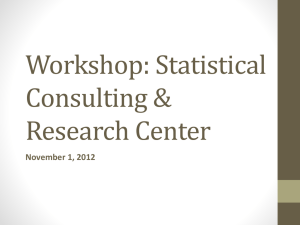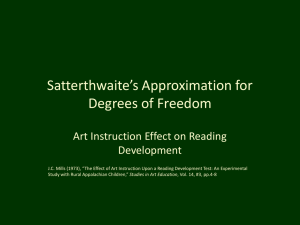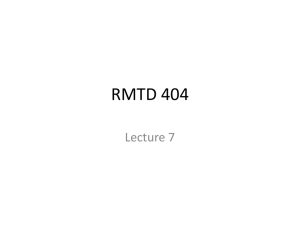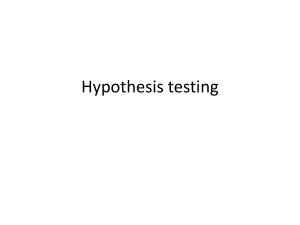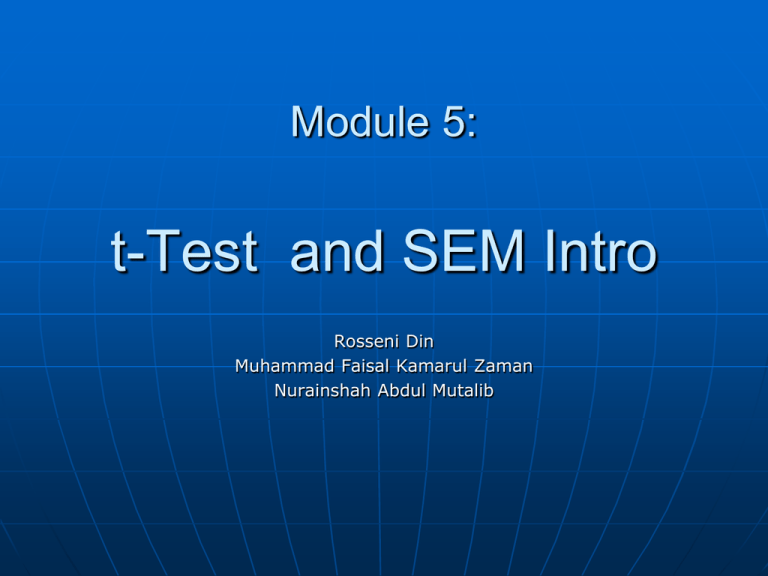
Module 5:
t-Test and SEM Intro
Rosseni Din
Muhammad Faisal Kamarul Zaman
Nurainshah Abdul Mutalib
Types
Independent-samples
• Compare mean scores of 2 different groups
Paired-samples
• Compare mean of the same group on 2
different occasions
Only comparing 2 groups or 2 conditions
More than that use variance
Independant
It needs
• One categorical variable / independent variable
• One continuous variable / dependant variable
What the test will do
• It will tell you whether there is a statistically
significant difference in the mean scores for
the 2 groups.
Assumptions needed
Paired
One group but 2 different occasion /
conditions
• E.g. pre/post test
Requirements: the same as independent
• One categorical independent
• One continuous, dependent variable
It will tell you whether there is a
statistically significant in the mean scores
Data Analysis Using
SPSS
t-test
t-test
Used to test whether there is
significant difference between the
means of two groups, e.g.:
• Male v female
• Full-time v part-time
t-test
Typical hypotheses for t-test:
a) There
is
no
difference
in
affective
commitment (affcomm) between male and
female employees
b) There is no difference in continuance
commitment (concomm) between male and
female employees
c) There is no difference in normative
commitment (norcomm) between male and
female employees
Performing T-test
Analyze →
Compare Means →
Independent-Samples T-test
Analyze
Compare Means
Independent-Samples T Test
Performing T-test
Select the variables to test (Test
Variables), in this case:
• affcomm
• concomm
• norcomm
And bring the variables to the “Test
Variables” box
Test variables are selected and carried to the box
on the right by pressing the arrow
The test variables: affcomm, concomm, and
norcomm
Performing T-test
Select the grouping variable, i.e.
gender; bring it to the “grouping
variable” box
Click “Define Groups”
Gender is the grouping variable
Performing T-test
Choose “Use specified values”
Key in the codes for the variable
“gender” as used in the “Value
Labels”. In this case:
1 - Male
2 - Female
Click “Continue”, then “OK”
Specified values for gender are: 1 (Male) and 2 (Female)
T-Test: SPSS Output
Group Statistics
affcomm
concomm
norcomm
GENDER OF
RESPONDENT
MALE
N
Mean
Std. Deviation
Std. Error
Mean
357
3.49720
.731988
.038741
FEMALE
315
3.38016
.696273
.039231
MALE
357
3.18838
.756794
.040054
FEMALE
315
3.15159
.666338
.037544
MALE
357
3.24090
.665938
.035245
FEMALE
315
3.27540
.647409
.036477
Mean scores for “Male” on the three test variables
The mean scores for “Female”
T-test: SPSS Output
Independent Samples Test
Levene's Test for
Equality of Variances
F
affcomm
Equal variances
as sumed
Sig.
1.048
.306
Equal variances
not assumed
concomm
Equal variances
as sumed
5.353
.021
Equal variances
not assumed
norcomm
Equal variances
as sumed
.656
.418
Equal variances
not assumed
2
t-tes t for Equality of Means
t
df
Sig. (2-tailed)
Mean
Difference
Std. Error
Difference
95% C onfidence
Interval of the
Difference
Lower
Upper
2.116
670
.035
.117040
.055308
.008442
.225638
2.123
666.213
.034
.117040
.055135
.008780
.225300
.665
670
.506
.036788
.055335
-.071863
.145440
.670
669.997
.503
.036788
.054899
-.071006
.144582
-.679
670
.497
-.034500
.050813
-.134272
.065271
-.680
663.726
.497
-.034500
.050723
-.134097
.065096
1
3
(1) Sig. is 0.306 (> 0.05) so there is no significant difference in the variances of the two groups
(2) so the row “Equal variances assumed” will be used to read the sig. of t-test
(3) Sig. level for t-test is 0.035 (<0.05)
Therefore there is a significant difference in the levels of affective commitment (affcomm)
between male and female employees.
From the SPSS output, we are
able to see that the means of the
respective variables for the two
groups are:
• Affective commitment (affcomm)
Male 3.49720 Female 3.38016
• Continuance commitment (concomm)
Male 3.18838 Female 3.15159
• Normative commitment (norcomm)
Male 3.24090 Female 3.27540
T-test: Interpretation
For the variable “affcomm”
• Levene’s Test for Equality of Variances
shows that F (1.048) is not significant
(0.306)* therefore the “Equal variances
assumed” row will be used for the ttest.
* This score (sig.) has to be 0.05 or less to be
considered significant.
T-test: Interpretation
Under the “t-test for Equality of
Means” look at “Sig. (2-tailed)” for
“Equal variances assumed”.
The score is 0.035 (which is less than
0.05), therefore there is a significant
difference between the means of the
two groups.
T-test: Interpretation
Independent Samples Test
Levene's Test for
Equality of Variances
F
affcomm
Equal variances
as sumed
Sig.
1.048
.306
Equal variances
not assumed
concomm
Equal variances
as sumed
5.353
.021
Equal variances
not assumed
norcomm
Equal variances
as sumed
.656
.418
Equal variances
not assumed
2
1
t-tes t for Equality of Means
t
df
Sig. (2-tailed)
Mean
Difference
Std. Error
Difference
95% C onfidence
Interval of the
Difference
Lower
Upper
2.116
670
.035
.117040
.055308
.008442
.225638
2.123
666.213
.034
.117040
.055135
.008780
.225300
.665
670
.506
.036788
.055335
-.071863
.145440
.670
669.997
.503
.036788
.054899
-.071006
.144582
-.679
670
.497
-.034500
.050813
-.134272
.065271
-.680
663.726
.497
-.034500
.050723
-.134097
.065096
3
1. Sig. is 0.021 (<0.05), there is significant difference between the variances
2. The row “Equal variances not assumed” is used for interpreting the t-test
3. The relevant significant level for t-test is 0.503 (>0.05)
Therefore, there is no significant difference between the two groups
T-test: Interpretation
For the variable “concomm”
• Levene’s Test for Equality of Variances
shows that F (5.353) is significant
(0.021)* therefore the “Equal variances
not assumed” row will be used for the ttest.
* This score (sig.) is less than 0.05, so there
is significant different in the variances of the
two groups.
T-test: Interpretation
Under the “t-test for Equality of
Means” look at “Sig. (2-tailed)” for
“Equal variances not assumed”.
The score is 0.503 (which is more
than 0.05), therefore there is no
significant difference between the
means of the two groups.
T-test: Interpretation
Independent Samples Test
Levene's Test for
Equality of Variances
F
affcomm
Equal variances
as sumed
Sig.
1.048
.306
Equal variances
not assumed
concomm
Equal variances
as sumed
5.353
.021
Equal variances
not assumed
norcomm
Equal variances
as sumed
.656
Equal variances
not assumed
2
.418
t-tes t for Equality of Means
t
df
Sig. (2-tailed)
Mean
Difference
Std. Error
Difference
95% C onfidence
Interval of the
Difference
Lower
Upper
2.116
670
.035
.117040
.055308
.008442
.225638
2.123
666.213
.034
.117040
.055135
.008780
.225300
.665
670
.506
.036788
.055335
-.071863
.145440
.670
669.997
.503
.036788
.054899
-.071006
.144582
-.679
670
.497
-.034500
.050813
-.134272
.065271
-.680
663.726
.497
-.034500
.050723
-.134097
.065096
1
1. The sig. is 0.418 (>0.05) so there is no significant difference between the variances
2. “Equal variances assumed” will be used to determine t-test
3. The Sig. of t-test is 0.497 (>0.05)
Therefore there is no significant difference between the means of the two groups
T-test: Interpretation
For the variable “norcomm”
• Levene’s Test for Equality of Variances
shows that F (0.656) is not significant
(0.418)* therefore the “Equal variances
are assumed” row will be used for the ttest.
* This score (sig.) is more than 0.05, so there
is no significant different in the variances of
the two groups.
T-test: Interpretation
Under the “t-test for Equality of
Means” look at “Sig. (2-tailed)” for
“Equal variances assumed”.
The score is 0.497 (which is more
than 0.05), therefore there is no
significant difference between the
means of the two groups.
Hands-on exercise
Use survey3ED.sav from
www.allenandunwin.com/spss
OR
http://rosseni.wordpress.com/2011/
07/15/spss-for-beginners/
Procedure for independent-sample t-test
1. Analyze > Compare means > independent
samples t-test
2. Move the dependent (continuos) variable (e.g.
total self-esteem) > Test Variable Box
3. Move the independent (categorical) variable (e.g.
sex) > Grouping Variable
Procedure for independent-sample t-test
4. Click define groups > type in the numbers used
in the data set to code each group. In the curent
data file, 1=males, 2=females; therefore, in the
Group 1 box type 1; Group 2 box type 2;
* if you cannot remember the codes used, right click on the
variable name and then choose Variable Information from the
pop-up box that appears. This will list the codes and labels
5. Click continue > ok
Intro to SEM
Structural Equation Modeling
Purpose of the Study
The study development of a model
for meaningful e-Training by blending
conventional and computer mediated
communication to cater to learners
with differentiated LS preferences. In
this study we call it the Hybrid
eTraining method.
The Extension: Conceptual Framework of a Hybrid E-Training System (HiTs)
Overall Research
Framework
Develop, implement and evaluate
a hybrid system implementation
that caters learners with
differentiated learning style
preferences, achieve meaningful
learning
Overall Research Framework
Content
Cooperativity
Delivery
Intentionality
Service
Hybrid
e-Training
Meaningful
e-Training
Construction
Structure
(HiTs)
(MeT)
Activity
Outcome
Authenticity
Individual
Learning Style
Preference
Kinesthetic
(LSP)
Tactual
Auditory
Visual
Group
n = 213
ICT trainers/trainees studying as postgraduate students/graduating fourth
year students participated in the Technology for Thinking/Computer Education
course in the year 2008
Overview of the Analytical Approach
Prelim Analysis
1a
1b
Formulate
hypotheses;
operationaliz
e variables;
examine
distributiona
l
assumption
Item
analysis;
reliability
analysis
principal
Componen
t analysis;
Modeling Procedures
2a
FF analysis
2b
Validate
measurement
models: HiT model
specification;
estimation; fit
assessment; path
adequacy; SMC
Validate other CFA
models : MeT and LSP
model specification;
estimation; fit
assessment;
path adequacy; SMC
2c
Test structural model:
(1) HiT MeT and (2) LSP HiT model
specifications; estimation; fit assessment;
path adequacy; SMC
Confirmatory Modeling Strategy
3
Test
the
fullfledge
d
model
Hypothesized HiT in relation to MeT and LSP . . .
e1
e2
e3
e4
e5
1
1
1
1
1
content
e19
e17
1
1
coop
1
inten
deliver
struc
serv
MeT
HiTs
const
1
activ
authen
outcm
1
e18
LSP
1
visual
audio
kines
tactil
group
indiv
1
1
1
1
1
1
e11
e12
e13
e14
e15
e16
1
1
1
1
1
e6
e7
e8
e9
e10
Reliability of the Instruments
Meaningful e-Training (MeT) Measure α =.89
Hybrid E-Training (HiT) Measure α =.93
Learning Style Preference (LSP) α =.88
-.52
HiT Measurement Model
Normed Chi-Square
RMSEA .101
CFI .993
TLI .975
p
.024
e5
content
.39
e4
3.155
deliver
e3
struc
e2
serv
e1
outcm
.77
.89
.82
.95
.79
HiTs
MeT Measurement Model
LSP Measurement Model
Normed Chi-Square 1.249
RMSEA .034
CFI .998
TLI .994
p
.288
Normed Chi-Square 1.095
RMSEA .021
CFI .999
TLI .998
p
.357
LSP
e16
.52
.74
.85
MeT
.83
coop
e4
inten
e5
const
e6
activ
e7
.95
authen
.74
.66
.85
.62
audio
visual
kines
group
e12
e13
e14
e15
.52
tactil
-1.01
e16
e8
.57
Structural Relationship of HiTMeT
Normed Chi-Square 2.509
RMSEA .084
CFI .972
TLI .956
p .000
e1
e16
content
.35
e2
deliver
-.08
-.24
.41
e3
struc
e4
serv
e5
outcm
.85
.86
.89
.80
.52
.81
.74
HiTs
.45
MeT
.84
.83
.96
coop
e6
inten
e7
const
e8
activ
e9
authen
e10
-1.06
Structural Relationship of
LSPHiTs
Normed Chi-Square 2.603
RMSEA .087
CFI .964
TLI .946
p .000
e1
content
.72
.46
e2
deliver
.25 -.34
e3
struc
e4
serv
e5
outcm
.63
.80
.91
.82
group
HiTs
.57
.52
.18
LSP
.66
e16
tactil
e14
kines
e13
audio
e12
visual
e11
.84
.74
.93
e15
Coverage
I. Statement of problem
Objectives of the study
Extension of the current hybrid model
II. Method
Setting; sample;
Modeling procedure
III. Results
Measurement model
Structural model
Full-fledged model
IV. Conclusion
Overview of the Analytical Approach
Prelim Analysis
1a
1b
Formulate
hypotheses;
operationaliz
e variables;
examine
distributiona
l
assumption
Item
analysis;
reliability
analysis
principal
Componen
t analysis;
Modeling Procedures
2a
FF analysis
2b
Validate
measurement
models: HiT model
specification;
estimation; fit
assessment; path
adequacy; SMC
Validate other CFA
models : MeT and LSP
model specification;
estimation; fit
assessment;
path adequacy; SMC
2c
Test structural model:
(1) HiT MeT and (2) LSP HiT model
specifications; estimation; fit assessment;
path adequacy; SMC
Confirmatory Modeling Strategy
3
Test
the
fullfledge
d
model
Adequacy of the full fledge Integrated Meaningful Hybrid E-Training (I-MeT) Model
Normed Chi-Square 2.394
RMSEA .081
CFI .945
TLI .929
p .000
e15
e17
content
.37
-.25
.43
e14
deliver
e13
struc
e12
serv
e11
outcm
e16
.79
.52
.80
.75
.84
.49
HiTs
.87
.89
MeT
.84
.84
.95
-.25
.15
LSP
.75 .67
.84
.51 .62
audio
visual
kines
tactil
Group
e10
e9
e8
e7
e6
.57
coop
e1
inten
e2
const
e3
activ
e4
authen
e5
-.95


